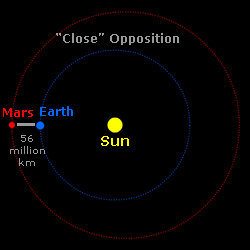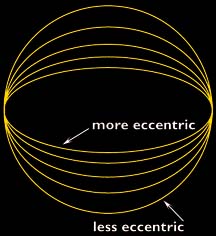Even at oppositon, Mars won't look this big from Earth. This picture was taken by a spacecraft.
Click on image for full size
Image courtesy NASA/JPL.
Mars Opposition on October 30, 2005
News story originally written on September 22, 2005
The planet Mars is closer to Earth than normal
right now. On October 30, 2005, the two planets will be very close to each
other. They will be about
69 million km (43 million miles) apart. Mars will look like a very bright red
star in the sky then.
Earth moves around the Sun more quickly than
Mars. Every 26 months, Earth "laps" Mars on "the inside lane".
When Earth passes Mars, astronomers call the event an "opposition".
During an opposition, the Sun, Earth, and Mars form a straight line with Earth
in the middle. Viewed from Earth, Mars is on the opposite side of the sky from
the Sun. Opposition is the time in each 26-month cycle when Mars and Earth
are closest together. Mars was even closer to Earth in August
2003.
Check out this movie of the
orbits of Earth and Mars to see where the planets are right now.
The distance between Earth and Mars is not always the same at opposition.
The orbit of Mars is an oval,
not a circle. Earth can be closer
or further from Mars at opposition, depending on where in Mars's orbit the
Red Planet is when Earth passes it. This time around the two planets get really,
really close together! Since Mars will be so close during this opposition,
it will be very bright in the sky and will look larger than usual through a
telescope.
You might also be interested in:

On August 27, 2003, Earth and Mars will be closer together than they have been in thousands of years. Mars will pass within 55,758,006 kilometers (34,646,418 miles) from Earth. Astronomers have calculated
...more
The Martian climate is more influenced by the shape of the Martian orbit than the climate of the Earth is influenced by the shape of the Earth's orbit. The orbit of Mars is more oval-shaped than that
...more
March 20, 2005 is the Vernal Equinox (the "first day" of Spring in the Northern Hemisphere or the "first day" of Fall in the Southern Hemisphere). It is also Sun-Earth Day! Sun-Earth
...more
The planet Mars is closer to Earth than normal right now. On October 30, 2005, the two planets will be very close to each other. They will be about 69 million km (43 million miles) apart. Mars will look
...more
Astronomers have identified another exoplanet, that is, a planet outside our solar system. This makes a total of 102 exoplanets that have so far been found by astronomers! The astronomers that identified
...more
Thanks to a couple of telescopes, everyone on the internet can browse through almost 2 million images. Stars throughout the sky were photographed by the Two-Micron All Sky Survey (2MASS) and are now available
...more
Earth may look perfectly spherical from space, like a giant marble, but it actually isn't! Instead, our planet is wider around the equator because matter is forced out as Earth spins (just as you feel
...more
Scientists at the University of Colorado at Boulder found evidence supporting a theory that salt is present on Io. Io is one of Jupiter's many moons. Recent observations from the National Science Foundation's
...more














